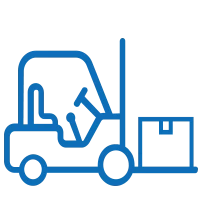Lift trucks are at the centre of productivity when it comes to moving products through a warehouse, distribution centre, or factory floor. Investing in fleet management for your lift trucks can help to increase productivity while lowering costs, increasing safety, and optimising the use of your forklifts and your workforce.
What does forklift fleet management do?
Advances in technology are making that process easier by transforming fleet management through software, forklift telematics, and GPS tracking. These solutions offer insights into operator and truck data that help companies make more strategic decisions when it comes to truck usage, battery life, fuel consumption, driver behaviour and maintenance needs.
The right technology provides insight into lift truck fleets and the operators that are managing and using them. It may also enable the tracking of key performance indicators and the support of best practices. That means managers have the ability to monitor what is going on, through different types of reports or usage information. With access to that data, managers, alongside their forklift suppliers, can look to maximise the fleet.
It can also enable companies to manage factors such as operator access. So that only operators with the correct training can access certain equipment. Pre-shift checklists can also be digitised, avoiding paper-based processes and helping to reduce time lost.
What can you track with forklift telemetry?
Telematics (or telemetry) solutions, such as Yale Vision, have become an invaluable tool for fleet management for many reasons. Companies are typically tracking four main areas, with each playing a key role in running and efficient operation.
- Utilisation proficiency—Companies want to know how their fleet is being used, what trucks are being used the most, and which operators are using them.
- Equipment diagnosis—Allows managers to address preventative maintenance needs and provide insights into battery life or battery information.
- Location services—This allows managers to see where trucks are being used and the locations of certain incidents, like impacts.
- Safety—Prioritising productivity and safety is a big part of fleet management. Telematics can help companies best protect their people and their assets.
How does forklift telematics help warehouses?
Using lift truck telemetry insights to improve one of these areas can often have an impact on improved efficiency across the board. For example, a large warehouse Yale works with originally implemented forklift telemetry solutions to better understand impact incidents. They were struggling with operators running into things and wanted to be able to analyse each incident.
Being able to track and analyse which operators are involved, or who might need more training helped improved the proficiency of this operation. It allowed them to reduce the number of impacts over time and also made them feel confident that they're protecting their people as well as their assets.
Realising the benefits of forklift telematics systems
While the upfront costs and overall education around forklift telematics solutions may still be barriers for some, global adoption is growing as the challenges warehouses and intralogistics operations face also increase. Managing a dwindling workforce continues to be a factor for many businesses, making any advantage critical.
Telemetry provides data insights that help companies to understand how people are using lift trucks, and how to maximise the return of the asset. Together, this can help support an improved total cost of ownership.
Get started with lift truck telematics for your warehouse fleet
Ask your expert local Yale dealer and Yale Vision and other fleet management technologies for your fleet.


